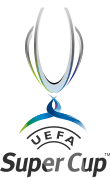De Meer Stadium
| De Meer Stadium | |
|---|---|

|
|
| The De Meer Stadium in September 1937 | |
| Data | |
| place |
|
| Coordinates | 52 ° 20 ′ 40 " N , 4 ° 57 ′ 0" E |
| owner | Ajax Amsterdam |
| start of building | February 23, 1928 |
| opening | December 9, 1934 |
| First game | Ajax Amsterdam - Stade Français 5-1 |
| demolition | 1996 |
| surface | Natural grass |
| costs | about 300,000 ƒ (1934) |
| architect | Daan Roodenburgh |
| capacity | 19,000 seats |
| Societies) | |
| Events | |
|
|
The De Meer Stadium was the former club's own football stadium and home of the Dutch football club Ajax Amsterdam in the Watergraafsmeer district of Amsterdam .
history
Built in 1934, it replaces the " Het houten stadium " ( German The wooden stadium ), which was no longer able to cope with the increasing number of spectators. On December 9, 1934, the opening of the 300,000 guilders expensive venue was celebrated with the game Ajax Amsterdam against Stade Français , which Ajax clearly won 5-1. At that time it had a capacity of 22,000 spectators, who were divided between the grandstands of the long sides (4,500 each) and the standing grandstands of the rear gate sides (6,500 each). The capacity increased to 29,500 places over time, but was later limited to 19,000 places for safety reasons. The club moved to the Olympic Stadium in Amsterdam for major European Cup or league games . Over time, the venue was no longer sufficient for Ajax's requirements. Security deficiencies led u. a. the expensive state incident for Ajax . As early as the 1980s there were plans to build a large stadium in Amsterdam, which was also part of the bid for the 1992 Summer Olympics . After the failed application, the Amsterdam Arena was built from 1993 to 1996 with over 50,000 seats and a closable roof.
Ajax's last game at De Meer took place on April 28, 1996 against Willem II Tilburg . Ajax Amsterdam won the last Eredivisie home game of the 1995/96 season with 5-1 goals. The last goal was scored by Jack de Gier (Willem II). The stadium was then demolished, the property sold to the city and the Park de Meer residential area built in its place. As a reminder of the old venue, the streets in the area were named stadiums, Esplanade de Meer , Wembleylaan , Praterlaan , Delle Alpihof , Bernabeuhof , Anfield and Stade de Colombes , where Ajax enjoyed great success. In the area were also twelve bridges after well-known Ajax players of the early 1970s, Johan Cruyff , Sjaak Swart , Gerrie Mühren , Ruud Krol , Johan Neeskens , Barry Hulshoff , Arie Haan , Wim Suurbier , Piet Keizer , Horst Blankenburg , Velibor Vasović and Heinz Stuy , named.
International matches at De Meer Stadium
The Dutch national football team played five games at De Meer Stadium, all of which they won. The first encounter, a qualifying game for the 1974 World Cup , was played by the Netherlands against Iceland (5-0) on August 22, 1973. The last encounter was on March 25, 1992 in a friendly against the team from Yugoslavia , which with ended in a 2-0.
| date | opponent | Result | Type of game |
|---|---|---|---|
| 22nd August 1973 |
|
5-0 | Qualification for the 1974 World Cup |
| March 14, 1984 |
|
6-0 | Friendly match |
| February 27, 1985 |
|
7: 1 | Qualification for the 1986 World Cup |
| December 9, 1987 |
|
4-0 | Qualification for the EM 1988 |
| March 25, 1992 |
|
2-0 | Friendly match |
Web links
- stadiumguide.com: data to the stadium (English)
- worldstadiums.com: Images of the stadium (English)
Individual evidence
- ↑ De staafgooier van Ajax - Sportgeschiedenis. In: sportgeschiedenis.nl. Retrieved December 27, 2018 .
- ↑ youtube.com: Video from the last game Ajax against Willem II (Dutch)
- ↑ youtube.com: Video about the streets and bridges with the names of the Ajax players (Dutch)
- ↑ voetbalstats.nl: Dutch football statistics page (Dutch)

